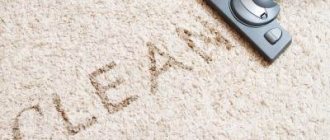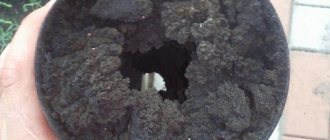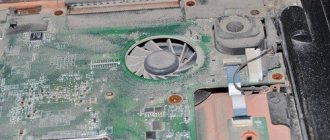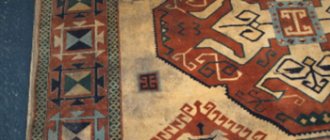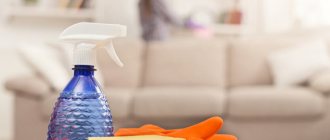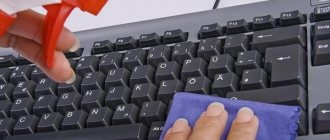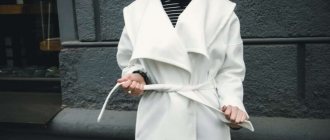In order for books from your home library to please not only you, but also your descendants, they require careful care. Dry clean twice a month. Treat publications with moisture-resistant binding with a soap solution. Remove odor with baking soda and mold with boric acid.
Proper care will not only extend the life of the publication, but will also protect its owner from allergic reactions arising from paper dust. We will learn how to clean books from dust, dirt, odors, and also get rid of mold stains.
Dry cleaning
It is recommended at least once every two weeks for publications stored in lockable shelves:
- Remove the books from the cabinet and wipe down the surfaces first.
- Leave to ventilate until the internal surfaces are completely dry.
- Start cleaning out your books. Wipe the cover with a dry microfiber cloth, and go through the sides with a vacuum cleaner.
- Place the volumes in their original place.
Wipe the cabinet with a damp cloth and glass cleaner.
It is not recommended to use a dust blower or hair dryer, as scattered dust particles will re-settle on the surface.
What harm do they do to humans?
It is known that a dust mite bite cannot be found on human skin. This is explained by the fact that they are too small, and therefore simply incapable of this. On the other hand, they constantly feed, and this leads to the fact that they secrete the products of their vital activity. This thesis refers to fecal matter or feces in which special digestive enzymes-proteins are present. These substances help destroy human skin cells so that mites can feed, and then they are also released in the feces of individuals.
Together with dust, a person inhales them (the size of one such feces is on average about 30 microns). Once on the mucous membranes or skin of a person, these substances begin to dissolve and dissolve the cells of the human body. As a result, the immune system begins to react to them as if they were an allergen, provoking a severe allergic reaction, especially if a person is genetically predisposed to it.
Laboratory allergy tests test for dust. If dust mites are present, a person may react to the P1 antigen, causing the corresponding symptoms.
Wet cleaning
This method is suitable for cleaning publications with moisture-resistant covers:
- Remove dirt from the side surfaces.
- If the cover is dusty, simply wipe it with a slightly damp cloth. Treat greasy areas with a cloth soaked in soap or soda solution.
- Remove any remaining detergent with a damp cloth.
- Leave the book to dry. To speed up the process, you can use a hairdryer.
- Place the cleaned items in the bookcase.
Important ! Do not dry books in direct sunlight.
How to return a book to its “marketable” appearance and purity?
- If the notes are written in pencil, it is easy to remove them with a special eraser. The only nuance that you should pay attention to is that you need to use the eraser carefully, without exerting force, so as not to damage the sheets of paper. Writing with a ballpoint or ink pen is much more difficult to remove. Find a special ink eraser and use it.
- Ink blots are removed with hydrogen peroxide. Using a cotton pad soaked in peroxide, treat the ink stain, then blot thoroughly with a paper towel. Do not place books with wet pages on the shelf; they must first be thoroughly dried.
- Grease stains on book pages can be removed with tooth powder or chalk. This method is only suitable for fresh stains. Chalk powder is applied to the stain and ironed on top through a white sheet of paper or through a white paper napkin.
- Old grease stains can be removed with aviation gasoline or a mixture of gasoline and magnesium oxide (burnt magnesia).
- The rust that appears will become discolored after wiping the stain with a cotton pad soaked in citric acid.
- Wash any remaining finger stains with soapy water. A gentler method is to rub the finger stains with soap, then wipe off the soap with a soft, damp cloth.
- Remove surface mold stains that have formed on damp pages using a soft brush or a soft vacuum cleaner attachment. . Make sure that mold spores do not get back onto the paper. Then treat the stains with ammonia (apply it to a cotton pad and wipe the infected areas, covering a slightly larger area). The same procedure can be done using a three percent formaldehyde solution. Let the paper dry. If stains are still visible, wipe them with hydrogen peroxide.
When working with books affected by mold, use a protective mask. Mold entering the human body is harmful to health.
When removing stains, be careful not to damage the paper surface. If you notice that the top layers of paper are being removed along with the stain, stop this activity immediately.
Eliminating insects living in books
If while looking at books you notice insects or their metabolic products, urgently carry out work to destroy the uninvited guests. In this case, you can use several methods:
After any wet cleaning, book pages should be dried by inserting them between sheets of blotting paper.
- Place volumes of books in a plastic bag and place in the freezer for several days. By the way, this method was invented by an American entomologist and is successfully used in large libraries. There are even special installations for freezing paper media.
- Place the infested books in a plastic bag, add any anti-moth chemical and place them in a separate well-closed box for several days. Be sure to spray your shelving with an insect repellent spray. Before putting books on the shelf, ventilate them well.
- Remove stains left by insects on paper by wiping with a cotton pad soaked in food vinegar or a mixture of ammonia and glycerin in a ratio of one to four.
Some more important tips:
- Baking soda will help remove the unpleasant smell of mold or dampness. It must be filled between the pages and the book should be put aside for several days. Then remove the dry soda with a soft brush or vacuum cleaner.
- If a book falls under water, it must be dried in a well-ventilated area, slightly open (to do this, place plastic spacers between the pages).
Without waiting for the book to dry completely, place it under the press. To make a press, you can take any heavy objects that will not leave dents on the book. Then flip through the book. If wet sheets stick together, carefully separate them. To ensure complete drying and alignment, the sheets can be ironed with a warm iron; first, the sheet is protected on both sides with white paper. - In order for books to live with you for a long time and delight not only you, but also your children and grandchildren, they must be used correctly. When you pick up a book to read, wrap it in its cover. Don't eat while reading.
- Use bookmarks, do not fold the pages. If a page breaks, carefully straighten it and leave the book for a while under the influence of gravity. Do not leave the book unfolded, especially with the cover facing up. The book may fall apart and the pages may fall out.
- Take care of your books. If for some reason you no longer need them, do not throw them away, but take them to the nearest library.
Interesting and necessary books for you and, of course, cleanliness in the house!
Getting rid of the smell
A book that is popular not only wears out over time, but also acquires a characteristic smell. A cheap remedy that every housewife has on hand will help get rid of it:
- Cover the table with a piece of cloth or newspaper.
- Pour a pack of soda onto the prepared surface; if there are any lumps, crush them.
- Sprinkle the powder over the book, pouring it between the pages and completely covering the cover.
- Leave for 5-6 hours.
- Shake off any remaining baking soda over the sink.
Borax powder can be used instead of sodium bicarbonate. Both products have disinfectant properties.
Removing mold
High humidity is detrimental to paper media as it leads to the growth of fungi. If your book has been covered in unsightly spots of black mold, this medicine will help get rid of the mold:
Dry the product outdoors. Wipe off the top layer of mold dust with a dry cloth. Using a watercolor brush, apply the boric acid solution to the stain. Be careful not to damage the paper and remove dirt with a dry cloth. Dry the sheet. Iron through fabric. Handle any damage. page.
When removing mold stains, do not forget about your own safety; carry out the work in a gas bandage.
With the advent of the digital format, there are fewer and fewer lovers of paper books, but for some, libraries from their favorite volumes still remain an important part of the interior. Books are very aesthetically pleasing, but over time they gather dust, a stale smell appears and other troubles appear. Let's figure out how to clean books from dust and prolong their life as much as possible.
Removing contaminants
It is better to remove fresh stains immediately
The following manipulations will help restore the original appearance of the tome:
- Erase pen marks, pencil marks or small stains with an eraser.
- Treat blood or insect marks with hydrogen peroxide.
- Remove blots from paint, cement and other heavy contaminants using fine-grained sandpaper.
Advice : preventive measures are always better than eliminating the consequences, so before reading, put a cover on the source of knowledge and do not eat while sitting at the book.
Description of the pest
Dust mites are small parasites that settle in living spaces and multiply there quite quickly. Their sizes are so small that it is almost impossible to see them with the naked eye. On average, their value can fluctuate between 0.1-0.5 mm, and therefore a person usually has no idea that he lives in a densely populated “communal apartment”.
These parasites are widespread across literally all continents. The normal life cycle of one individual is about 65-80 days. During this period, the female can make hundreds, if not thousands of clutches, each of which will contain up to 60 eggs. The ideal environment for their habitat is a temperature in the range of 18-25°C, and with high humidity they begin to actively reproduce.
It is noteworthy that mites in house dust, or rather their metabolic products, are one of the most common causes of asthma.
In addition to dust, these arthropods can safely live in:
- Mattresses (they especially love pile products);
- Woolen blankets;
- Bed linen;
- Upholstered furniture;
- Pillows;
- Perinakh;
- Soft baby toys;
- Animal bed and so on.
It is noteworthy that if synthetic analogues of the above elements are used for a long time without regular processing and washing, they will also not disdain. A dust mite is capable of clinging to clothing, and therefore, even if there was no dust mite in the apartment before, it is enough to bring one individual from public transport, sitting at school or another place to your home so that the invader can inhabit the area in the shortest possible time.
But the most favorite habitat of this pest is the bed. In just one week, about 1 g of skin particles are retained in the underwear of just one person. In one day, a person generally loses up to 1.5 skin cells, dandruff and other elements. Considering that sweat and heat are still released during sleep, this place is perhaps the best living space for dust mites.
1 g of dust can contain up to 150 species of dust mites. These parasites can be eliminated without problems using folk remedies or chemicals at home.
Storage recommendations
The way books are kept largely determines their condition. The storage location should not be damp. Recommended temperature and air humidity parameters: 18-22° C and 50-60%.
Books should not be exposed to direct sunlight. Store them on closed shelves in an upright position. Do not place them too tightly and on top of each other - the pages should “breathe”.
Don't forget to wash the shelves where books are stored. Return everything to its place only after the cabinets have completely dried.
Cleaning is important not only for the safety of books. Some people are allergic to paper dust. Having picked up a copy, instead of the pleasure of reading, they get streams from their eyes and nose. Take care of the proper storage of books and the good health of the people in the house, and then the library will become your pride.



